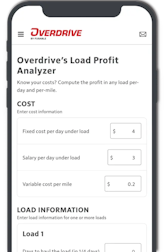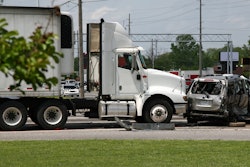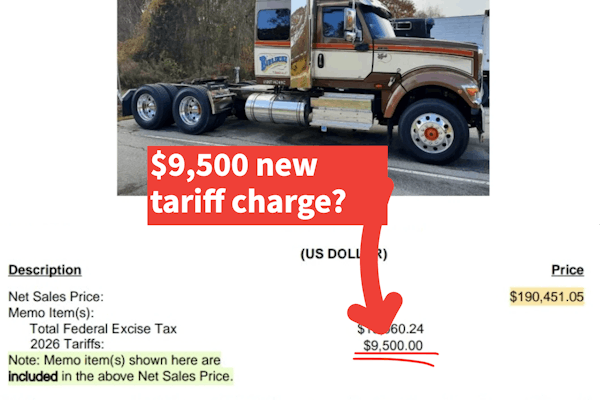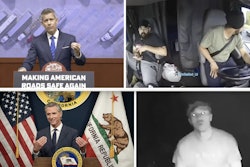Last month DOT Secretary Sean Duffy held a fiery press conference calling out California, New Mexico and Washington for not enforcing President Donald Trump's English language proficiency mandate for all truck drivers in the country and threatened to withhold federal funds if the states didn't change within 30 days.
As of September 25, that 30 days has come and gone, and California has once again openly defied DOT. Washington additionally has not budged on the issue.
"As we saw with the horrific Florida crash that killed three, when states fail to enforce the law, they put the driving public in danger," Duffy said when he announced the 30-day deadline on August 26, referring to Harjinder Singh's deadly U-turn crash earlier that month. “States don’t get to pick and choose which federal safety rules to follow.”
Overdrive reached back to the California Highway Patrol, which previously told this publication it was not enforcing ELP as an out-of-service violation, and did not hear back. That's after four emails and a voicemail.
Yet CHP staff at commercial vehicle enforcement stations confirmed that the sate was not enforcing ELP as an OOS violation "until the governor orders us to."
California typically automatically adopts the Commercial Vehicle Safety Alliance's updated out-of-service criteria every April, and the state hasn't made any special rulemaking efforts to adopt the new ELP rules. A rulemaking effort in California would include a 45-day comment period and potentially an additional 15-day comment period if edits are made. Even an emergency rulemaking procedure in California would likely take more than 30 days.

California hasn't put forth any such rulemaking. The U.S. DOT itself also did not comment on California blowing through Secetary Duffy's 30-day deadline.
Duffy in August said states that didn't come into compliance with respect to ELP enforcement would face losing "up to 100%" of Motor Carrier Safety Assistance Program (MCSAP) funding, which helps states train officers and enforce commercial motor vehicle safety regulations. California in 2024 received $30 million in MCSAP funds.
But the threat of losing that $30 million hasn't incentivized California to move ELP enforcement along quickly. To put the amount in perspective, the state's entire government operates with a $300 billion annual budget and an $11 billion "rainy day" fund.
DOT had also called out Washington and New Mexico for not enforcing ELP as an OOS violation.
Washington also did not respond to Overdrive requests for comment, but weigh station personnel in the state confirmed they were not putting drivers OOS for ELP violations. The state of Washington has a roughly $35 billion annual budget (it calculates its budget biannually) and around $1.2 billion in a rainy day fund.
New Mexico, which got into a heated exchange with DOT over bodycam footage of a July traffic stop with Singh, said it had begun enforcing ELP as an OOS violation after initially seeking more information from DOT and not hearing back.
[Related: New Mexico releases video of Harjinder Singh passing an inspection in English]
"When USDOT issued its announcement in late May, we began developing a standardized ELP test to ensure consistency," a representative for New Mexico's State Police said. "Our officers have been trained and are enforcing the ELP requirement. To date, the New Mexico State Police has issued 258 ELP violations."
Not all of those 258 violations in September have resulted in OOS conditions for the driver, as New Mexico has a border zone in which Mexican drivers can operate without ELP. But as for retaining MCSAP funding, the representative said it doesn't expect to lose the money.
New Mexico did share with Overdrive that even after catching flack from DOT for an "inexplicable lack of enforcement" recorded on the bodycam footage NMSP shared of its walkaround inspection of Harjinder Singh and his carrier's truck, the DOT still did not share any other information with the state on how to enforce ELP. (NMSP maintains Singh successfully completed a Level II inspection in English.)
At the end of August, DOT said state law enforcement had taken 3,100 drivers OOS for lacking ELP. However, the same press conference that called out California, New Mexico and Washington included DOT saying that many of those OOS drivers continue to drive and inspectors in other states often don't find out about the driver's OOS condition.
The Commercial Vehicle Safety Alliance explained that inspectors can find out if a driver has been placed OOS, but they typically don't do that.
[Related: Why state police are letting drivers placed OOS for English violations go free]
 FMCSA Chief Counsel Jesse Elison addressed CVSA on Monday, but didn't mention ELP enforcement. CVSA
FMCSA Chief Counsel Jesse Elison addressed CVSA on Monday, but didn't mention ELP enforcement. CVSA
Asked if CVSA's mission of uniform enforcement of commercial regulations had been compromised by the state's defiance of DOT's ELP demands, Gildea said no.
"Although we’re experiencing some implementation challenges related to the ELP changes that occurred outside our regular procedures, overall there is a comprehensive adoption of the federal regulations and a uniform roadside inspection program," she said.
FMCSA Chief Counsel Jesse Elison addressed CVSA's annual meeting on Monday, which includes representatives from all states.
The one detail of DOT's ELP enforcement conversations with states that FMCSA would confirm to Overdrive was that Elison "did not make any substantive comments about ELP during his remarks on Monday at the CVSA event."










